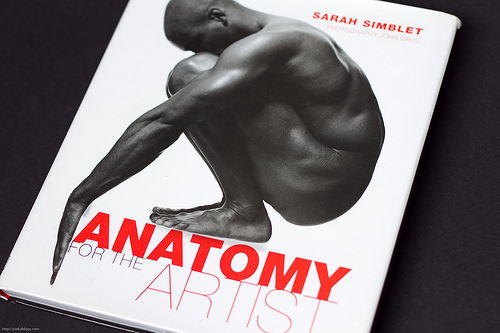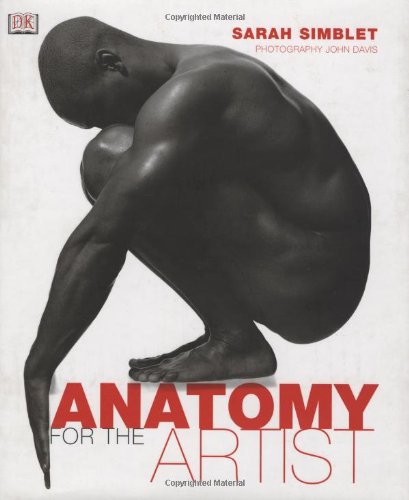Book Review: Anatomy for the Artist
Sarah Simblet's anatomy book is a bit of a mixed bag for me.
Unlike other anatomy books, this one features lots of stunning photography of the body in nude. The models have lean muscular figures and the lighting and poses are great. Some photos are used as underlays with translucent skeleton overlays on top. Unfortunately, there aren't any muscles overlay using this method.
As a book that's targeted at artists, I thought the drawings were not good enough. They are done in a sketchy style that makes it difficult to make out different muscle groups. It takes a bit of effort to understand what you're looking at. You can't draw what you can't make out. That's the major weakness of this book.
There's not much on the head and neck. Overall, the book lacks the depth of coverage you find in other anatomy books like Human Anatomy for Artists by Eliot Goldfinger, which presents layers over layers of muscles each in different drawings, or the concise explanation of Classic Human Anatomy: The Artist's Guide to Form, Function, and Movement by Valerie L. Winslow.
With its great photography but not very defined drawings, it's a general anatomy reference book at best.
-
This book was borrowed from Basheer Graphic Books for review purposes. You can order the book from them. Check with Basheer on Facebook or visit their website.
Anatomy for the Artist is also available at Amazon (US | CA | UK | DE | FR | IT | JP)










Visit Amazon to check out more reviews.
If you buy from the links, I get a little commission that helps me get more books to feature.
Here are direct links to the book:
Amazon.com | Amazon.ca | Amazon.co.uk | Amazon.de | Amazon.fr | Amazon.it | Amazon.es | Amazon.com.au | Amazon.co.jp | Amazon.cn
This book was borrowed from Basheer Graphic Books for review purposes. You can order the book from them. Check with Basheer on Facebook or visit their website.
Comments
I have to disagree
I have to disagree completely. This is my favorite anatomy book and the only one I ever recommend to artists who need help. I bought many, many anatomy books as a young artist--all the big names and some of the unknown--and they taught me little to nothing. Those books are always all drawing, and mostly (if not exclusively) isolated parts of the body. If you are learning to draw the figure, this is frustrating. You are effectively copying someone ELSE'S idea of what the form of a figure looks like. If only given isolated areas, you don't know how the body works as a whole. The best way to learn is to use anatomy books focused on photography like this one. Draw directly from what you see, not Bridgman's stylized version (which is more appropriate for advanced artists).
I would like this book to be expanded, but that's the only downside I see. When I first discovered this book years and years ago it was a complete breath of fresh air. I still use it, and it's the most dog-eared in my collection.
Interesting. I see this one
Interesting. I see this one (at least i think it is this one!) being recommended all around and was considering buying it.
Which anatomy books do you recommend, Parka?
Cheers!
Oops! I guess I skipped a
Oops! I guess I skipped a whole paragraph where you do just that!
anatomy books seem to be a
anatomy books seem to be a very subjective matter. i, for one, often find photography to be near useless except for illustrating a point that has already been made. i.e. having been taught the insertions, the interplay and functions of a certain muscle group and then being able to see it in a well chosen photo, or illustrate the simultaneous bunching and relaxing through a series of poses, things like that. as a didactic tool themselves, i find photos to (literally!) be too superficial.
also, drawing the gesture often is something that is neglected in anatomy books. thus, i dont think there really is one anatomy book to bind them all, whose lecture will make all and everything about the human body clear to you. mixing them up seems to be the way to go - i, for example, like stephen rogers pecks "atlas of human anatomy for the artist" - as it has not only a systematically structured section on bones and muscles (its isolating body parts, though - which, at one point in the whole matter, is a didactic necessity), more medical illustrations offset with drawings, followed by sections on the effects of age, body fat distribution, sex...
then, there always is andrew loomis' "figure drawing for all its worth", which is less about anatomy, but more about actual figure drawing, and walt stanchfields "drawn to life", focussing on animation gesture drawing (animation is the single most gesture conscious application of drawing - there is a lot to learn from animation masters)
and then, there are photography books. they are useful in a supplementary role, so i usually keep some around as well.
anatomy and its application in figure drawing is a complex manner - i fear there are no shortcuts.
the overlays are actually a quite good idea, but from what i see in your video, seem to be done more as a gimmick. i imagine how useful these could be in tracking how certain bones are hidden in the body in certain poses, and poke through the surface in certain places - and why. making them a tool for constructing landmarks, or showing how the problems of certain drawings where solved, etcetera - that could indeed be useful.
ps.: i like the listing of muscles and their function in pecks atlas so much, its actually the first place i go to when i hurt myself during exercising. ;)
interesting books first time
interesting books
first time i encountered an Anatomy book with with photographs
I found "Classic Human
I found "Classic Human Anatomy: The Artist's Guide to Form, Function, and Movement" by Valerie L. Winslow to be of most help in extending my knowledge of the human body. I am an aspiring sculptor though reading through it is a breath and the knowledge translates over no matter what medium you're using. In fact, I am more than halfway through the book already, given the fact that I purchased it less than 2 weeks ago and I do know a whole lot more about the anatomy now than I ever did before. Not only that, I am also aware of what landmarks bones and muscles make on the surface. It is my first anatomy book though I did stumble upon Sarah Simblet's Anatomy for the Artist at a local library beforehand. Listing through its pages, I haven't found anything of interest in the book being reviewed here (besides beautiful, lean models) that would help me locate the most important landmarks on a model as well as what I should look out for.
Mrs. Winslow's book does have its flaws as nothing is perfect. Its pluses outweigh the minuses by a ton and the information on the anatomy given there is far more important to us artists rather than knowing what each bone looks like from 4-5 views or what exact bumps and texturing they have. For that matter, Human Anatomy for Artists by Andras Szunyoghy comes in to help.
In case I want to see human bodies, 3d.sk is the way to go as it offers every kind of body you can think of - from bodybuilders to midgets, anorexics obese, young and old people.
There is no perfect, average body type we can fit our characters in. It just doesn't exist. Besides, it is the differences people are interested in, not the similarities.
Good review. Thanks.
Good review. Thanks.
I saw this one in a local
I saw this one in a local bookshop a year ago and really liked it; but a couple of pages were damaged (a bit ripped and folded) and the front cover had a deep cut in it - so I thought that paying the whole price for a damaged book would be kind of dumb. If I was gonna pay that much for it, I at least wanted it to be in good condition. A little while later, not even THAT ONE was available anymore and they never got any more in stock. I'd still like to get it someday. I, for one, find photography much more useful than drawings. It feels somehow wrong to draw according to other people's sketches: a little bit like cheating. And I get the feeling that if the author made a mistake, I'll just go ahead and copy the mistake. Not to mention the fact that the author may have a completely different style from my own.
In any case, I'm glad to see this one reviewed on your blog. I'd been wondering whether you knew of its existence and what you thought of it. :)
I got this book as a gift.
I got this book as a gift. It's not entirely bad, but you don't need this if you have access to the internet.
Also, If you are struggling to learn human anatomy - it's essential to know the skeleton and muscle insertions on the bones first. I recommend medical interactive media. That's how I learned.
This book has excellent
This book has excellent photography with very dynamic poses, and the overlays are insightful in understanding surface with muscular form. Also, having actual photographs of a real skeleton is very useful, as finding a real one can be enormously expensive! Simblet's drawings are more gestural but she knows her stuff and draws from memory also. I like the reenactments of Old Master paintings too.
Greatest book you can find...
In reply to I have to disagree by iola (not verified)
Greatest book you can find....after that it's nude photography books that will help you further. This is to me the alltime best book on anatomy for people who draw or paint...





Add new comment